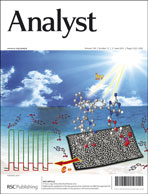High throughput DNA basepair mismatch detection is an ultimate goal for earlier and point-of-care diagnostics. However, the size of a target sequence on single nucleotide mismatch detection will critically impact the design of sensors in future. To study the potential impact of target size, the probe and target strands of unequal size were hybridized in the absence and presence of single nucleotide mismatches along the sequence. After hybridization, the shorter target sequences form overhangs in the probe strand while longer target sequences form overhangs in the complementary strand. The resulting double stranded DNA hybrids were printed on gold surfaces and the electrochemical response of the films was studied by scanning electrochemical microscopy without signal amplification and label. The redox mediator, [Fe(CN)6]4−, experiences lower repulsion in the vicinity of mismatch containing ds-DNA films, which ultimately manifests into higher feedback current regardless of the size and hybridization position of the complementary strands. Kinetic rate constants monitored right above the ds-DNA films show k0 = 4.5 ± 0.1 × 10−5 cm s−1 for the short sequence hybridized at the upper portion of the probe while k0 = 4.1 ± 0.2 × 10−5 cm s−1 for longer complementary strands which has only top overhang. It suggests that hybridization position is important for mismatch detection in short complementary stands. However, in longer complementary strands, mismatches are easily detectable in the absence of bottom overhangs.

You have access to this article
 Please wait while we load your content...
Something went wrong. Try again?
Please wait while we load your content...
Something went wrong. Try again?


 Please wait while we load your content...
Please wait while we load your content...